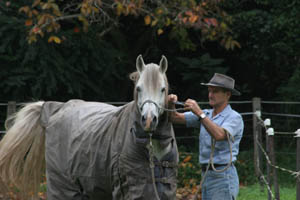 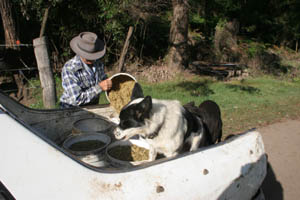 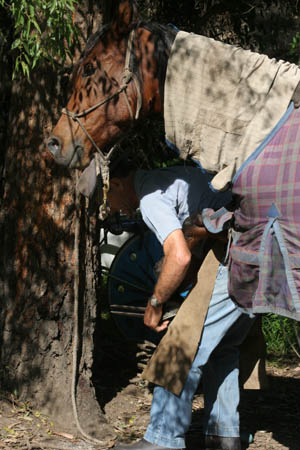 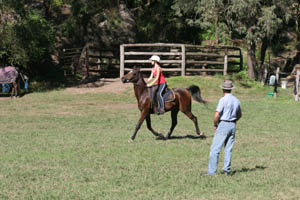 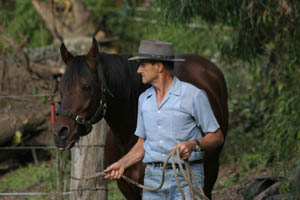 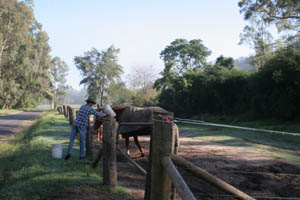 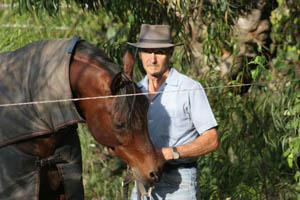 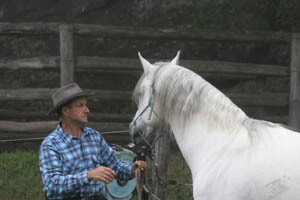 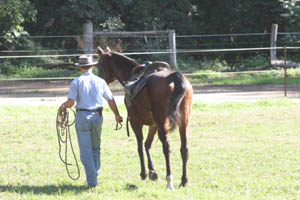 | Sunday May 13 2007 Though Ron Males is what you might call partly retired from owning an Arabian Stud farm, he still has plenty of things to keep him busy. He feeds his horses twice a day with help from his 2 dogs (some horses are boarded horses), he still shoes his horses, he gives riding lessons, and in between he goes “to have a scratch in me’ garden.” He still breaks in one horse a year, just because he likes doing it. He told me what he and Val have always liked in Arabians, which is, in one word, Quality. He said the horse shows, especially in the U.S around the 1980’s or so, started getting away from what the Arabian breed was originally about. Nobody stops to think why horses have (or had) what they did. What was the Arabian horse? A desert war horse. Broad heads, deep jowls for chewing, nostrils that flare widely to let in air, strong necks. Small ears on stallions - the stallions didn’t have to do any listening for protection; the mares did that. They had bigger ears because they had to spend all their time eating, to nourish the foals at their side while probably being in foal again, and still protect their foals and the herd by listening all around them, while the stallions ate 6 hours a day and looked pretty the rest of the time. The Bedouins kept the foals in their tents, so if they weren’t gentle they were gotten rid of; they rode mares into battle because they were quiet - the stallions would have trumpeted their arrival. Why is the tail of the Arabian carried high? It’s to let the air flow underneath them to naturally help cool down a horse that travels miles and miles over the desert sand carrying heavy weight - the same place you first go, along with the head, to cool down a horse with water, underneath the hind legs. Well-muscled thighs and gaskins contribute to producing brilliant action. Ron and Val didn’t train their horses to have such good action, they bred for it. In the showing, Ron never clipped his horses, and he never put eye makeup on, (the horses, that is), and he never put grease on their faces. “If they don’t look good without the makeup, they just don’t look good.” And every single photo I saw of their horses were absolutely beautiful - a natural beauty, and all horses with substance. Ron and Val believe in heart scores - measurement of the size of the heart. Of course it’s only one part of the whole picture, but they believe that if your horse has a small heart, he may be good, but he won’t ever reach that great potential because he’s limited by the capacity of his heart to work. This criteria has worked well for them over the years. The heart score on Milex, one of their stallions, was 140, the highest measurement, and the highest that had been recorded up to that time. Ron and I talked about electrolytes - he never feeds them except a handful of table salt a few days before an endurance ride. They need to be hydrated before they go to the ride, he says; you don’t work on hydrating your horse during a ride. You teach your horse to drink on the trail when you’re out training: come to water, put him in the middle of it, don’t let him eat grass, wait till he drinks - and he won’t need electrolytes, especially if you’ve brought him to the ride hydrated. Teach him to stay there and drink while everybody else is galloping by. Trying to get him to learn to drink during the ride is too late. “Two minutes lost in a ride watering my horse saves me 5 minutes down the trail because my horse won’t be as stressed.” He talked about today’s Natural Horsemanship trainers - those guys don’t always tell you all that they’re doing because they want it to look like magic. He watched Monty Roberts work with an unbroken horse once, and watched him instructing the horse subtly with little jerks and tugs on his halter (getting him used to pressure) while he was lecturing the audience with his voice and his other hand. He never told the audience what he was actually doing with the horse, so it looked like magic when Monty walked off with this previous problem horse following him like a dog. Ron rivals any of these showy trainers, only he doesn’t do it for show - it’s just his way of life around horses. He also doesn’t always cotton to the approach of complete gentleness to breaking. When ‘green horse people’ (my words - those who haven’t been around horses enough to really know what they’re about yet) try to copy these Natural horsemanship methods, it may work for a while, but what happens the horse deviates from the plan? Last week Ron was shoeing a horse somebody brought in for him to work on, and the horse jerked away and ripped open his hand with a nail. So next day, after he got his hand sewed up, he tied the horse’s back foot up, and let him fight himself (instead of Ron). That went on till the horse got tired of it, and he was good as gold after that. You can still be gentle, but you can also be firm and let the horse teach himself things. “Let the horse fight himself if he’s going to fight, not you.” He said “I’m always amazed by horses, even after all these years. I like to watch horses interact, watch how they respond to each other. If the dominant mare in a herd wants to walk through the herd, she flares her nostrils and slightly wrinkles her nose, and slightly pins her ears, and the horses part like the ocean for her. She’s not forceful about it. If we can communicate like horses, they understand us better. I like to work with the very young ones, especially. If you handle them with firmness, so you’re the dominant one, but with gentleness, they respond so amazingly easily.” Ron believes that in general, females are better with Arabians than males who like to dominate. With an Arabian, if a man wants to fight him or force him to do something, “he’ll have a fight and a half on his hands.” Ron hand pasture breeds his stallions, if that’s what you’d call it. He takes them on a long lead rope into a pasture with a group of mares. The one or ones that are interested come up, the stallion picks his mare, and breeds her. He’s allowed to act like a stallion - prance and kick and leap around on the end of the lead rope - but once he’s done, he’s instantly brought back to human reality and is expected to behave properly with Ron. (And they do, because that’s the kind of horses Ron had/has.) His horses are all also taught to stand still when their lead ropes are dropped on the ground. He says “WHOA,” drops the rope (he showed me with Ralvon Mark), and walks off, and the horse stands there until he’s asked to move or his lead rope is taken up again. We also talked about his endurance training methods: “It’s the time you spend on the horse’s back that gets them fit, not the miles you put on them. Them carrying your weight is what wears them out.” He has a treadmill that he’s used for 20 years. During the show seasons, the stables horses were always turned out every day, and walked on the treadmill, by walking two minutes and trotting for 6-8 minutes. Ron (and Val too) is one of those older and wiser horsemen whose methods have proven successful over the years, one that you can learn a great deal from by just watching. He still gives seminars on endurance (in fact he and Val were at a seminar at the Toft’s in December, where he was reunited with Chip Chase Sadaqa, who he rode to be 2nd in the 1987 Quilty) to get young people interested in the sport. He doesn’t do so much endurance riding himself, just a few training rides now and then with his grandchildren. I’d say, if you see him out there on the trail and you don’t know him, introduce yourself, because he’s one person that you can learn a great deal from. |
Tuesday, May 15, 2007
Ralvon Arabian Stud Part II
Subscribe to:
Post Comments (Atom)
No comments:
Post a Comment